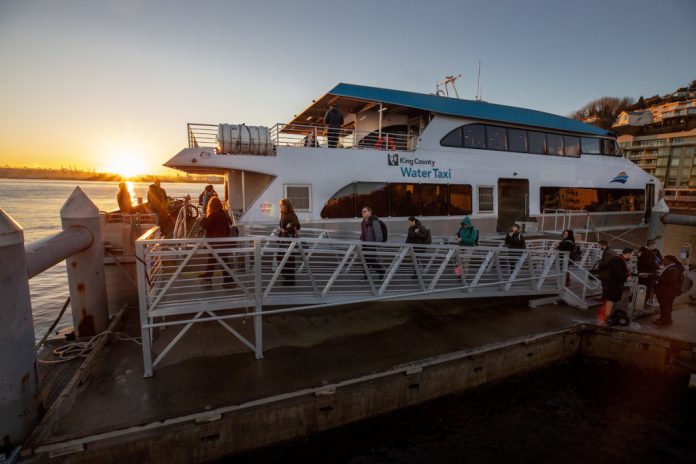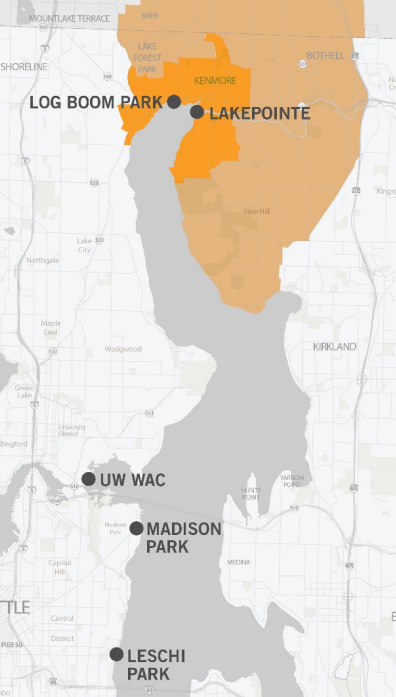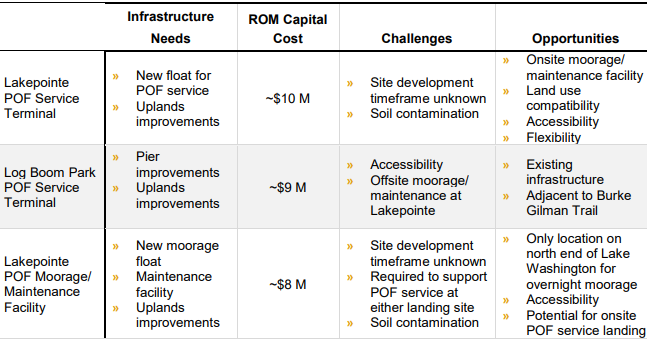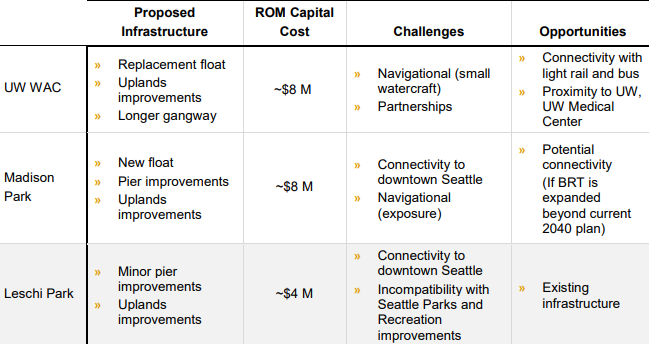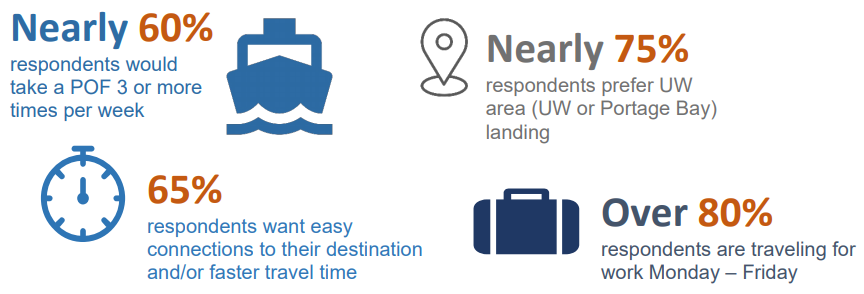Before the Puget Sound Regional Council shared their draft passenger only ferry study in December, King County Metro had submitted a report on implementation of a Kenmore water taxi this past July. PSRC’s study identified a Kenmore-University of Washington route as one of the more cost-effective passenger ferry routes opportunities, as recognized by the King County Council. Governance over county ferry services transferred over to the council from the King County Ferry District in 2015, when the council directed the Marine Division to revisit the ferry district’s exploration of county ferry opportunities.
This leads to the council’s direction to the Marine division to report on implementation of a Kenmore water taxi route in the 2019-2020 county biennium budget that requires an update on facility assessment, ridership projections, cost estimates, an environmental impact analysis, a report on planning efforts and funding opportunities needed for a route, a summary of outreach and coordination, and a sketch of next steps.
Further exploration of a Kenmore water taxi comes on the heels of the two existing water taxi routes, West Seattle and Vashon Island to downtown, performing above expectations. Public interest in new transportation options is increasing, with population also rising on both ends of the route. Kenmore is expecting a 10% increase in population and 30% increase in jobs by 2030, and is currently served by Metro and Sound Transit through their Woodinville and Seattle services. As a part of the Sound Transit 3 measure, a SR-522 bus rapid transit service will come to Kenmore in 2024 or 2025 and connect with the 145th Street Link Light Station in Shoreline.
A passenger-only ferry route for Kenmore would provide North King County communities another mode of transportation, increasing transit capacity and resiliency in the area. A Kenmore water taxi would seat up to 150 passengers, the equivalent of two light rail cars or 150 single-occupancy vehicles. On resiliency, the water taxi can avoid roadways and the incidents that may afflict them, during the current West Seattle bridge closure crisis the West Seattle water taxi has been able to increase service and be a critical connection for the community.
Metro’s findings
To kick off their analysis, Metro first evaluates the possible routes from Kenmore. For the City of Kenmore, Log Boom Park and Lakepointe are identified as landing sites. As for destinations, Bellevue, Downtown Seattle, Redmond, and University of Washington were identified as key destinations for people in Kenmore. Bellevue and Redmond are inland and were quickly eliminated. UW Waterfront Activities Center, Madison Park, and Leschi Park landing sites in the City of Seattle see further review for their access to the university and Downtown.
The study eliminates Log Boom Park and Leschi Park sites as unsuitable for a ferry operation and ruled incompatible for ferry service by Seattle Parks, respectively. This leaves service from Lakepointe to UW WAC, and Lakepointe to Madison Park. Kenmore to UW would take 30 minutes one-way and 70 minutes round-trip. The route to Madison Park manages to shave that time down to 25 minutes one-way and 60 minutes round-trip. While Madison completes the route faster, it’s virtually eliminated by the Kenmore-UW route’s near triple forecasted ridership. That disqualification is supported by community feedback that prefers a UW area landing, and reinforces demand for a ferry within the community.
When comparing travel time to bus transit, Metro’s report and the Puget Sound Regional Council’s report share similar conclusions on faster commutes. The two reports estimate similar ridership numbers, though Metro presents even better numbers as the route matures. Positive similarities end here.

The moment we arrive to cost, King County Metro provides some much more sobering numbers compared to the regional council’s draft study. Metro estimates annual operating cost nearly double that of the region council’s. That leads to an operating cost per rider of over $32, nearly triple that of the existing system in 2019. If we use forecasted 2025 numbers that reflect a pre-pandemic and mature Kenmore water taxi, cost per rider falls closer to the existing system. Metro also notes that even with 2019 numbers, if a Kenmore water taxi was incorporated into the existing system then the total system will still achieve it’s 25% farebox recovery goal.
For initial capital costs, Metro estimates vessels costs at around $15.4 million or $3 million more than the regional council’s estimate. Metro is also able to provide landing site and maintenance facility costs that the council is unable to. In total, $24.8 million for a landing site at UW WAC, and a landing site and maintenance facility at Lakepointe. Both sites require significant upgrades to existing and undeveloped facilities that require an assortment of permitting approvals.
Metro also provides preliminary environmental analysis reviews on elements of earth, air, water, and plants. New ferry operation could cause erosion of shorelines from vessel-generated waves. Diesel-powered propulsion will contribute to greenhouse gas emissions. Both of these concerns can be mitigated by vessel construction with efficient hull design, foil assistance, and Tier 4 engines. No impact is expected with regard to water, and plant life.
Uncertainty and Next Steps
As required by the 2019-2020 county budget, next steps like funding, partnership, and implementation are included. Metro’s Marine Division is primarily funded by a dedicated property tax levy with support of fares, grants, and bonds. Increased property taxes and federal grant opportunities from the Federal Highway Administration, Federal Transit Administration, and Department of Transportation are outlined. Final agreements would need to be made with the UW, City of Kenmore, and Lakepointe property owner. Further environmental review and outreach are noted, but assuming those steps were to be processed without major interruption Metro projects that a Kenmore-UW ferry could be operational in around three years after work begins.
In a September proviso response Metro makes sure to conclude that the report was developed with pre-pandemic highly favorable growth assumptions, and recommended against implementation of a Kenmore water taxi at this time, given the current impacts of the pandemic and unknown effect afterwards. The route does remain in Metro’s long-range plans for potential expansion of the water taxi service.
While Metro uses the pandemic to pause thought on implementing a Kenmore water taxi, skepticism was warranted with the figures provided by the agency anyways. Ridership and cost estimates in the report have a Kenmore-UW water taxi lag behind the other water taxi routes in cost effectiveness. Initial capital costs hover around $40 million, meanwhile Metro’s RapidRide projects are being delayed, abbreviated, or downgraded. Kenmore will also be benefiting from BRT via the ST3 package. Ferry expansion is certainly a powerful way to improve regional transit connections–if it’s worth the cost and when it may come is up to the King County Council.
Shaun Kuo is a junior editor at The Urbanist and a recent graduate from the UW Tacoma Master of Arts in Community Planning. He is a urban planner at the Puget Sound Regional Council and a Seattle native that has lived in Wallingford, Northgate, and Lake Forest Park. He enjoys exploring the city by bus and foot.

